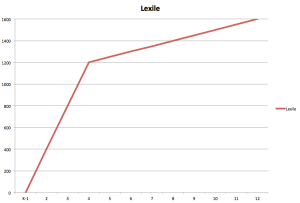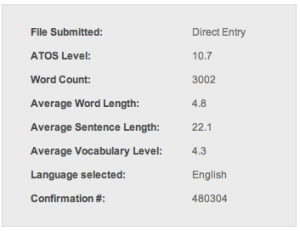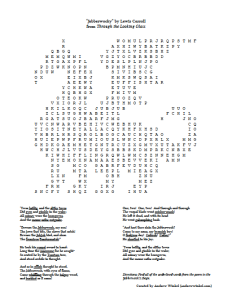Andrew Winkel's Blog, page 4
February 17, 2014
Sign of the Times
 Less discrete than a paperback nestled beneath the bathroom vanity, this handy stand should have the option of a power cable for convenient charging. Oh, and a feature to block the Skype app when the iPad is seated (like its owner).
Less discrete than a paperback nestled beneath the bathroom vanity, this handy stand should have the option of a power cable for convenient charging. Oh, and a feature to block the Skype app when the iPad is seated (like its owner).
January 16, 2014
Some Observations on the Limitations of Reading Levels
As a teacher, I have used reading levels to match readers with texts. Reading levels are any of the myriad systems developed to evaluate texts for readability. Typically these systems assign a rating or measurement that equals an age or a grade or a number to the text. Thus, we can pick up a paperback, look on its back cover, and discover a reading level included by the publisher that we interpret, “This book has a reading level of 5.4, which means it is readable by a fifth grader in his or her fourth month.” The essential truth about all reading levels is that there is a continuum of complexity that begins with the easiest texts on one end and moves through increasingly complex texts to end with the most complex text. Plotting each text at a point on this continuum allows readers to compare readability between texts.
The thing is, as I deal with reading levels as both an educator and parent, I find that there’s something that nags me as imprecise and, yes, I’m going to say it, wrong about the various reading levels that have been developed and are in use today. Books show up with ratings that just don’t make sense: some books are clearly written for younger readers, but they have very challenging reading levels; or books with adult concepts show up that have very basic reading levels. Over the years, I’ve observed this phenomenon, and what it comes down to is this:
Reading levels are useful tools, but they have limitations.
These limitations are most visible when educators or readers place too much emphasis on reading levels, when they use them as boundaries instead of guidelines, when they embrace reading levels as dogma. This comes out of my own experiences as both a parent and a teacher, from the expectations placed on my own children by other educators, and the expectations I’ve placed on other people’s children in my own classroom.
The two systems for measuring text complexity that I am most familiar with are ATOS, a product of Renaissance Learning, and Lexile, a product of MetaMetrics. Both companies have built their businesses around their unique systems for evaluating reading levels, and both have unique formulae that they use to evaluate text. These systems are different but parallel, and I will refer to both.
First, an acknowledgement: both Renaissance Learning and MetaMetrics know and communicate clearly that reading levels have limitations; they don’t pretend otherwise. It’s at the reader’s end of things where I’ve seem reading levels misinterpreted or misunderstood, either by readers themselves, or by the parents and teachers helping guide their child/students’ reading. Also, I am in no way capable of explaining any of the intricacies of determining reading level: the formulae, the math calculations, the terminology. I think these things may be outside my reading level.
ATOS
So much information has already been shared about ATOS by Renaissance Learning that I would never be able to do a better job explaining it than they already have. Read even a little of the information they have posted at their website and you, too, will begin to appreciate the effort that has gone into creating the ATOS tool for determining readability.
ATOS values are decimal based, with the lowest book level a 0.1 and the highest value a 16.9. The ranges correspond to school years, from Kindergarten (16).
The foundation of the ATOS formula is “the number of words per sentence, average grade level of words, and average characters per word” (Milone, 10). ATOS then takes into account the overall length of the text, recognizing that shorter texts are more readable than longer texts. Further, the formula factors sentence length as it corresponds to overall text length.
ATOS has a substantial amount of data to drive it; Renaissance Learning determines reading levels for its Accelerated Reader program, a subscription web-based product purchased by school districts to provide independent testing on more than 150,000 book titles (See my blog post on using the Accelerated Reader website as a tool to find the word count of published books). Not only has each title been run through an ATOS calculator, but student performance on a test after reading each title is available to Renaissance Learning. This puts Renaissance Learning in a unique position because they can determine a reading level for the text, then compare that reading level to test results from real readers.
A database of every book that has been measured for ATOS is available through www.arbookfind.com. However, shorter texts may be uploaded and analyzed with the ATOS text analyzer.
Lexile
The State of Illinois, in its ISAT results, uses Lexile as the readability measure it connects to student progress. Each child’s ISAT report includes a suggested Lexile range. Rather than use a grade equivalent, MetaMetrics created a continuum from zero through over 1600 to define a text’s readability. According the MetaMetrics, “The Lexile measure is shown as a number with an “L” after it — 880L is 880 Lexile.” While it may be tempting to associate the Lexile continuum as grade levels, this is not the case. A searchable database of books with their measured Lexile scores is available at www.lexile.com. The actual details of the Lexile formula is not publicly available, and any attempt to determine what the Lexile of a book or passage might be that has not come from MetaMetrics is only an estimate or guess because the company uses proprietary formulas to calculate a text’s readability.
Observation #1: Reading Levels Encourage Oversimplification
Because reading levels create concise numeric ratings for books, the tendency for users is to rely too heavily on the measurement without taking into account other information about either the book or the reader that would fall outside the textual information that reading levels are capable of measuring.
How this plays out for educators and readers is that the reading level becomes the first criteria to consider in choosing a title rather than other, intrinsic motivators. For me this is like the proverbial cart before the horse: As a reader, my first consideration is whether or not I want to read the book. With reading levels, interest is secondary; readers select books within a range of readability levels, omitting any exposure to those titles outside that range. Go ahead and walk through a library, try to pick a book from the shelf, experience that serendipity of finding a title with a cover that screams, “Read me!” that you’ve stumbled on by accident in the stacks. Or that book your best friend just stuck into your hands with a quiver in his voice as he told you it was the best book he’s ever read. Oops, those books are outside your Lexile. If you touch them; they’ll burn your fingers.
This oversimplification on the part of users is exacerbated by another factor, specifically…
Observation #2: The formulas used to calculate text complexity do not factor concepts, context, or narrative complexity.
This is especially problematic with fiction texts. Text complexity measures the measurable, like the length of words, words per sentences, sentences per paragraphs, syllables per word, etc. However, texts may include concepts and narrative elements that require inferencing and background knowledge far beyond the scope of the reader’s experiences.
Take, for example, Dune by Frank Herbert. The Hugo and Nebula Award-winner is rated with an ATOS Book Level of 5.7 and a Lexile of 800L. However, Dune posits a far-future empire with Machiavellian intrigues in a complex political and economic power struggle. Power plays between the Emperor and House Atreides, the Bene Gesserit breeding program, the idea of the Spacing Guild and its monopoly on space travel; all of these are conceptually very advanced for a fifth-grade reader. When Feyd-Rautha Harkonnen attempts to assassinate his uncle, the Baron Vladimir Harkonnen, he does so by hiding a poisoned needle beneath a patch of artificial skin on the inner thigh of a slave boy. The implications are never elaborated upon by Herbert, who expects his reader to make inferences about the Baron’s proclivities. Dune is, in concept, a robust read, but both the ATOS and Lexile place it in Common Core Grade Band 4-5. My son Alex read it as a fifth grader and did not pass the test.
American Gods by Neal Gaiman is another Hugo and Nebula Award-winner. It rates a 5.3 ATOS Book Level and has no Lexile associated with it. This book covers an amazing assortment of mythological beings from multiple old-world sources. It includes violence. It includes sex. It even includes violent sex. Did I mention that that ATOS would put that in the range of a fifth grader?
The Killer Angels by Michael Shaara is rated at only a 4.7. I am reading it right now to my sons, Alex and Bryan, aged 12 and 10. The sheer number of characters is overwhelming, and this is compounded with the individual histories that each character brings into the story. It’s a brilliant book; one that I think does an exceptional job helping the modern reader understand the complexities that surround war and honor, and especially the American Civil War, which is too easily explained (and too simply understood) as a war over slavery. Shaara is able to delve into the unique psyche of multiple characters from both the North and the South and give his readers nuanced interpretations of why the fight was worth facing death and loss. Fourth grade? No way.
In Common Core State Standards for English Language Arts & Literacy in History/Social Studies, Science, and Technical Subjects Appendix A: Research Supporting Key elements of the Standards, the authors define a “three-part model for determining how easy or difficult a particular text is to read.” The text then defines three components as
Quantitative: “aspects of text complexity, such as word length or frequency, sentence length, and text cohesion, that are difficult if not impossible for a human reader to evaluate efficiently, especially in long texts, and are thus today typically measured by computer software.” The “Quantitative” component is the reading level of the text.
Qualitative: “aspects of text complexity best measured or only measurable by an attentive human reader, such as levels of meaning or purpose; structure; language conventionality and clarity; an knowledge demands.”
Reader and Task Considerations: “variables specific to particular readers…and to particular tasks must also be considered.”
Thus, of the three components elaborated upon as factors in determining readability, only one focuses on the component we currently call reading level.
Oddly enough, this inability to do more than interpret the “Quantitative” aspect of a text has a very obvious and dramatic consequence for readers because…
Observation #3: Nonfiction “style” earns higher reading levels than fiction “style.”
The formulae cannot distinguish genre or purpose; they can only calculate the measurable components of the text. A reader who is expected to read more challenging books will find that the titles available to him or her are weighted more heavily by non-fiction.
Take a look at the following results pulled from www.arbookfind.com during November, 2013 (the exact number of results will not be reproducible because of the constant addition of new titles to AR’s database of available quizzes, but I would expect the percentages to remain consistent).
Renaissance Learning divides books into four interest levels to help match readers with texts that will be appropriate for their age group:
Lower Grades (LG K-3)
Middle Grades (MG 4-8)
Middle Grades Plus (MG 6 and up)
Upper Grades (UG 9-12)
Using the recommended ATOS Book levels for Common Core, I’ve broken out the total number of English language quizzes based on fiction versus nonfiction. Additionally, I’ve presented both the total quizzes available and the percentages of those quizzes as fiction versus nonfiction.
For the those books with interest levels for grades K-3, the easiest reads are dominated by fiction, and as the text complexity increases, the slant toward nonfiction increases.
Lower Grades (LG K-3)
CCSS Grade BandsRecommended ATOS Book Levels# Fiction# Nonfiction% Fiction% Nonfiction
2nd to 3rd2.75 to 5.1419,18091395%5%
4th to 5th4.97 to 7.031,0254,16720%80%
6th to 8th7.00 to 9.985707%93%
9th to 10th9.67 to 12.0100NANA
11th to CCR11.20 to 14.1000NANA
By the middle grade titles, the slant is even more obvious because the number of titles that match the middle grade interest and readability lean significantly to nonfiction. Look at the 6th to 8th grade band, which is the level I teach; for those books that would interest a middle grade reader, fully 97% are nonfiction. A paltry 330 are fiction. Call me a fiction prude if you like, but I came to my love for nonfiction through fiction. Fiction was my gateway drug. Maybe other people loved nonfiction from the start, but I was a prolific reader of fiction during my middle grade years, and there is nothing in this chart that would have made me into the reader I am today.
Middle Grades (MG 4-8)
CCSS Grade BandsRecommended ATOS Book Levels# Fiction# Nonfiction% Fiction% Nonfiction
2nd to 3rd2.75 to 5.1415,7386,95069%31%
4th to 5th4.97 to 7.037,63218,01830%70%
6th to 8th7.00 to 9.9833010,6033%97%
9th to 10th9.67 to 12.01183545%95%
11th to CCR11.20 to 14.1031517%83%
I’m not really sure about this “Middle Grades Plus” category. I would have assumed that there would be overlap from the “Middle Grades (MG 4-8)” titles, but given the total quiz counts, this doesn’t appear to be true. What hasn’t changed is the absolute dominance of nonfiction over fiction. I am very concerned here because, as a parent, both of my sons have been told that they need to challenge themselves with texts that are at higher reading levels. But look at the total quizzes available: there are only 29 quizzes at the 9th to 10th grade reading level. There are only 363 (45 289 1 28) tests available that are above sixth grade. For this interest level, it’s either all fiction through 5th grade band or all non-fiction after 6th grade band; there is no balance between the two.
Middle Grades Plus (MG 6 and up)
CCSS Grade BandsRecommended ATOS Book Levels# Fiction# Nonfiction% Fiction% Nonfiction
2nd to 3rd2.75 to 5.141,8013098%2%
4th to 5th4.97 to 7.031,45315390%10%
6th to 8th7.00 to 9.984528913%87%
9th to 10th9.67 to 12.011283%97%
11th to CCR11.20 to 14.1000NANA
For those readers who are in the upper grades, the picture is bleak for fiction. There are only 137 (45 61 31) titles to choose from; you better not be a prolific reader after sixth grade because there are only 137 fiction books that will be at your reading level. Another interesting fact is that of the books that would interest an upper grade reader, the vast majority (a whopping 93%) are written at the ATOS 4.97 to 7.03 grade level.
Upper Grades (UG 9-12)
CCSS Grade BandsRecommended ATOS Book Levels# Fiction# Nonfiction% Fiction% Nonfiction
2nd to 3rd2.75 to 5.142861097%3%
4th to 5th4.97 to 7.035,8091,14584%16%
6th to 8th7.00 to 9.98453,3861%99%
9th to 10th9.67 to 12.01611,1425%95%
11th to CCR11.20 to 14.103115816%84%
I can’t tell you why the ATOS formula is slanted toward non-fiction, but Renaissance Learning is well aware of this fact. Indeed, they launched a study to determine differences between fiction and non-fiction for this very reason. Anecdotally, I observed that the age of fiction tends to increase as the reading level increases, so that the most difficult fiction titles fall into those written over one hundred years ago.
All of these observations bring me to my own conclusion, namely…
Conclusion: As reading proficiency increases, the value of reading levels declines
Proficient readers do not need to rely on reading levels. For as far as I can remember I have never in my life consulted a reading level to select a book. Never. Let me repeat: not once at any time in my thirty-nine years of life, including the twelve years I spent in public education and the four years I spent earning my Bachelor’s and the two years I spent getting a Master’s degree have I ever consulted a book’s readability in determining whether I was capable of reading it. If it ever was an important consideration for me, it would have been before fourth grade, when I was a developing reader. Once I became proficient enough to read independently, those boundaries were unnecessary. Like Goldilocks, I knew which porridge was good to eat; some might be too hot, others might be too cold, but some were just right.
I am a proficient reader; my sons Alex and Bryan are proficient readers. I am not concerned that they will have a sudden desire to read Snotty Nose Jones books; they’ve moved on in their tastes, and even if they decide that they want to read books that are beneath them, the books will be so easy that they will move through them quickly and move on. No harm done.
Additionally, the oversimplification of reading levels fails to address this simple truth: Readers’ growth will begin to plateau as they become more and more proficient readers.
My son Bryan received his fourth grade ISAT test results which included a recommended Lexile range of 1135L to 1235L. Take a look at this chart which I reproduced from Lexile.com:
Revised Lexiles to Match Common Core Grade Bands
CCSS Grade BandsCurrent Lexile Band"Stretch" Lexile Band
2nd to 3rd450L-725L420L-820L
4th to 5th645L-845L740L-1010L
6th to 8th860L-1010L925L-1185L
9th to 10th960L-1115L1050L-1335L
11th to CCR1070L-1220L1185L-1385L
This information puts Bryan’s progress at the very top of the chart — as a fourth grader! What kind of future growth should Bryan’s teachers expect from him? The answer: very little. Bryan is not going to have measurable growth in his reading level for the next eight years of his schooling; his growth will be in the other components of readability: the “Qualitative” and “Reader and Task Considerations” aspects of readability, and neither of these can be determine by mechanical means.
Assuming Bryan is able to go forward from fourth grade and achieve the highest Lexile score (it tops out at 1600) by the time he graduates high school, here is a simplified visual chart to show his anticipated reading level growth over his primary and secondary years:
Notice the plateau? That’s because Bryan’s reading level grew very quickly initially. It’s time to let him develop the necessary maturity and experiences to interpret the more advanced conceptual content that is going to be outside his ability to understand. As a reader he will not be motivated if he is forced to work within his reading level. The available materials will be limited in number and those titles that are available will be overwhelmingly nonfiction. His rapid rise in reading levels should be rewarded with the authority to self-select content that appeals to him, even if it is only in the 4th-5th grade band because (we’ve already seen it) fiction is not well-represented in the higher reading levels.
This is my great concern: we’ve come to focus so heavily on using reading levels to assist those students who struggle with independent reading that we treat proficient readers in the same way as struggling readers, and so stifle their passion with our good intentions.
The preceding blog post has an ATOS of 10.7; here is the report for ATOS Level according to the ATOS Analyzer:
Resources:
“Common Core Common Core State Standards For English Language Arts & Literacy in History/Social Studies, Science, and Technical Subjects Appendix A: Research Supporting Key Elements of the Standards.” Common Core State Standards Initiative, n.d. Web. 16 Jan. 2014. <http://www.corestandards.org/assets/Appendix_A.pdf>.
Milone, Michael, Phd. “The Development of ATOS.” Renaissance Learning, 2012. Web. 16 Jan. 2014. <http://doc.renlearn.com/KMNet/R004250827GJ11C4.pdf>.
“Text Complexity Grade Bands and Lexile Bands.” The Lexile Framework for Reading. MetaMetrics, Inc., n.d. Web. 17 Jan. 2014. <http://www.lexile.com/using-lexile/lexile-measures-and-the-ccssi/text-complexity-grade-bands-and-lexile-ranges/>.
“Using ATOS to Address Text Complexity.” Renaissance Learning. N.p., 2014. Web. 16 Jan. 2014. <http://www.renlearn.com/textcomplexity/usingatos.aspx>.
November 18, 2013
Resurrection!
One of the most exciting things about the internet is its ability to either connect or resurrect those elements from my past that would — at another time — have been lost to entropy.
Here are some of my favorite examples of media that have been resurrected since I was a kid to be enjoyed by a new generation.
Elfquest
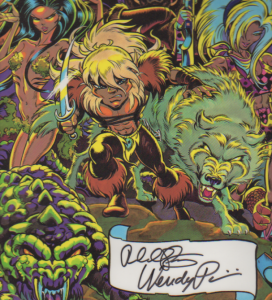 Detail from a signed promo poster I found in my stuff from 1993.
Detail from a signed promo poster I found in my stuff from 1993.Elfquest, by Wendy and Richard Pini, is a fantasy comic series that was started in 1978. I never read the complete run of Elfquest when I was a kid, because getting all of the issues meant visiting comic book shows or shops, and also cost money. I had some of the WaRP Graphics issues, and some of the Marvel issues, but I didn’t have the entire series. A couple of years ago, I decided to look up Elfquest on the internet to see if there were graphic novels available, and lo and behold, the entire comic book series was available to read online! Not only the original series, but every Elfquest comic written, over 6,500 pages of comic book, was available at
http://www.elfquest.com/gallery/OnlineComics3.html
I read the original quest with my kids as our bedtime stories. We used my laptop because the pages were viewable fullscreen and had been re-colored. I asked my kids if they wanted to try to read from the copies of the comic books that I owned, but the WaRP issues were black and white, and once you’ve started reading digital color there’s no going back. Parents, note that I did skip pages 15-16 in issue 17, and you might, too, depending on the age of your kids; it’s essentially a sort of pre-battle Saturnalia.
Lone Wolf
 I actually had a copy of this book…
I actually had a copy of this book…The Lone Wolf series of books by Joe Dever took the idea of “choose-your-own-adventure” titles and added role-playing game mechanics to the story-lines, creating an interactivity that usually got me killed during my first encounter with a bad guy.
I hadn’t thought about these books in years until last week when my friend Johnster dropped me a note that the books had been fan released in app form:
https://play.google.com/store/apps/details?id=com.GDVGames.LoneWolfBiblio&hl=en
This app takes the content that Joe Dever has made available via projectaon, a site dedicated to sharing the entire Lone Wolf series for reading online.
Avalon Hill’s Dune

This image is NOT the game I pulled out last weekend to play with my boys; instead, this is a picture of the components completely redesigned by a fan named Ilya Baranovsky, whose entire creative endeavor can be downloaded and printed out from BoardGameGeek. I’ve already begun printing the components because—let’s face it—this is a beautiful re-rendering of the original game.
The idea that fans can take a game from the past and re-energize it is phenomenal. I picked up a copy of Wizard’s Quest, which the boys and I played a few weeks ago. They enjoyed the random attacks from orcs and dragon in this game, and I’m looking forward to playing it again. The thing is, there is a fan expansion called Advanced Wizard’s Quest that makes use of the board from Wizard’s Quest, but includes entirely new counters for new races and a totally new ruleset!
This isn’t the only game I came across like this. I managed to pick up a copy of Scotland Yard at a garage sale a few years ago for something like a quarter. A guy named Gioacchino Prestigiacomo created an Italian variant based on Blade Runner, and the rules are posted through here.
Dune II
 I spent hours on this game twenty years ago…
I spent hours on this game twenty years ago…I have to leap-frog here from board games into video games. I wasn’t much of a video gamer because I never bought the systems. The most I had was a computer, and after a Commodore 64 it was the clearance model IBM compatible from Wal-mart, so running power games was never in my cards. One game I did own was Westwood Studio’s Dune II, a game that I actually won as the Atriedes.
Once Alex, Bryan and I finished our very short board game version of Dune (it turns out that Dune should really have six players for it to be competitive), the boys remembered that I have a copy of Dune II on an old computer in the basement. They asked to play it for a while, but it wasn’t long before Bryan raced upstairs with his Nexus because he had found an edition available at Google Play: Dune 2. So here it is, twenty years later, and the game I was playing (in this house, actually, where I am writing this; at that time it was my grandmother’s house, and I stayed here to house-sit, and I brought my giant computer because it was so exciting to get out of my parents’ house and sit-up all night playing video games and eating Gardetto’s!) is now available to a new audience on a new platform, the mobile device. Dune II is still every bit as playable as it was then, which is a testament to its design.
These are all examples of how the books and games from my childhood have grown and evolved in the era of the internet. I’m thrilled to be able to revisit them, and also to share them with my kids, and maybe even to adapt them in new directions with new ideas and creativity.
My compliments to Richard and Wendy Pini, and Joe Dever who have made their works available for people to enjoy through the internet. It takes an enormous amount of faith to share intellectual property; I’ve done it with a few of my old works, and I have some intention to follow suit with some of my newer work, but not until you’ve purchased a copy of Raceboy and Super Qwok Adventures from Amazon or Barnes and Noble!
November 3, 2013
Nanowrimo Update
Should I be writing? Yes.
Am I writing? Well…yes…just not on my “novel”…
Around October 30th I figured out how to organize the many notes I’ve been journalling for Flowergirl and Dr. Destructo Adventures, and today I was finally able to get my notes transferred to index cards. Here is what I’m looking at right now:
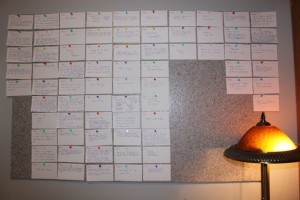 I’ve divided the cards as follows.
I’ve divided the cards as follows.
CONFLICT: Ideas that explain a complete problem or conflict, each of which could form the basis for a story or sequence.
TOPIC: Any idea that does not have enough meat to be a CONFLICT, but could be useful in one or more of the stories. Some TOPIC cards deal with character ideas, others deal with thematic ideas, and still others deal with little funny insights that I would like to include somewhere.
STYLE: These cards details a specific form that I would like to include, ranging from poetry to epistle to specific sentence forms (I’ve been re-listening to Brooks Landon’s lectures on Building Great Sentences).
TO DO: When I want to remind myself that I need to perform some sort of research, that goes on a TO DO card.
I will have to report later whether all of this work has been beneficial. Although Scrivener does have notecards as a part of its design, there is something about good old fashioned index cards and a tack board that makes arranging information satisfying. Now I just have to get it into a draft.
Briefly, I want to mention how things are going after three days of Nanowrimo. The truth is that I hate almost everything I write. Plain and simple: hate it. It’s awful. It doesn’t make sense. It’s weak. It’s embarrassing. I don’t want to look at it, or read it, or acknowledge it. I’m angry about how bad it is, and the only reason I’m going to continue is this: if I have something, I can at least work with it and fix it. If I don’t have anything, I can’t fix it. So I’m going to continue writing words that I hate with the hope that once I’ve completed all of these words, I will be able to take them and re-fashion and re-envision them and re-mold them into something that I love, and this re-creation will never have been possible without starting somewhere with something.
October 28, 2013
Nanowrimo 2013
Yes, folks, I’m trying again. After last year’s pathetic performance, I am once again going to attempt to write Flowergirl and Dr. Destructo Adventures.
Last year’s attempt derailed, possibly because I was trying to write a story that Chris suggested. It wasn’t that the idea wasn’t good; rather, it turned into a retelling of a book I wrote years ago called Fairy Ring. The story didn’t feel fresh or original; it felt like a copy. This year’s version will be completely re-envisioned. Like Raceboy and Super Qwok Adventures, it will be a collection of shorter stories, with the possibility that some will be connected. Although the theory would be that there will be an overarching plot-line, I can’t see how that will work, and in truth: I’m letting it grow organically, trusting that the story will blossom on its own as I push through the many ideas I’ve been collecting.
I’ve added the widget to my sidebar so you can check my progress, send encouragement my direction, and even chastise me when you see me in public since I could be holed up somewhere writing.
October 7, 2013
Jabberwocky Word Search
This word search was originally creating around 2000 using a program that was then freely available for designing and printing word searches. I do not remember the name of the program now, but it did have an option to output the word search as a text file, which I did, then imported into Microsoft Word for editing.
I recently dug this file up on an old backup CD and modified some of the fonts to give it a better look when printed. Perhaps someone somewhere may be able to make use of it.
Word searches are one thing I have never been fond of doing. I also do not assign them in my classes. If I have ever used this one, it was as a supplement to reading the poem. What I do like about this word search is that it includes the full text of the original poem.
Unfortunately I do not have a copy of the key, if one ever existed.
September 28, 2013
Dancon Fall 2013
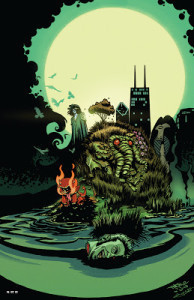 Dancon Fall 2013 Limited Poster
Dancon Fall 2013 Limited PosterOne of the great things about attending a show like Dancon is getting to meet all of the awesome creators and see how much talent is out there. Chris told Missy that I spent the whole day walking around instead of sitting at the table, which wasn’t exactly true. I just spent most of the day walking around (the rest of the time I covered the table for Chris to check out the comic vendors!).
We did get mentioned by some bloggers who we had an opportunity to visit with.
Anthony Feinman came by, and we had a great conversation. We met in 2012 at the Kankakee Fantasycon, where we were both creators. We actually traded books, and I got the better deal because he only got one book, but I got three. He recorded his impressions of Dancon on his blog, Sleeping in Panels.
Peter G, another Fantasycon alum, stopped to visit and did a very nice write-up for bleedingcool.com. This one includes a snapshot of the goings-on, including a very aloof Chris.
Mandy Madrox interviewed all the creators. I appear around minute 22 in what is probably the most underwhelming 20 seconds of film ever created. See it here. The best part of the video is you can see some of the vibrant creativity I am talking about. There are some adult content types in here, so those of you with littlies shouldn’t assume it’s all good just because Raceboy and Super Qwok Adventures is kid friendly.
Of course, the Dancon Facebook page has a couple of albums of photos from the event, which is a great way to view some of the costumes people had, and also to witness many of the characters who came together to put on the show.
In my meanderings, I did manage to buy some things:
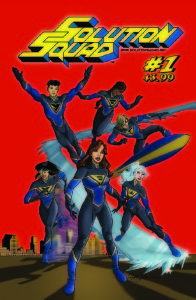 Solution Squad #1 by Jim McClean
Solution Squad #1 by Jim McCleanIssue #1 of The Solution Squad, Jim McClain’s project to fuse mathematics and comics. I’ve already begun passing it around to the math teachers in my school. I hope I can help generate some interest, especially since Jim has bulk discounts that bring the price of a classroom set of 30 down to half price. Jim is a fellow middle school teacher, so he’s in the trenches. He even participated in a panel at C2E2 on integrating graphic novels into a Common Core curriculum. In the past I’ve tried to read at least one graphic novel with my language arts classes per year because I think the medium is so important to introduce kids to (and they love it; last year we read two Bone books and the first Amulet book). Having Jim use it to go a step further and turn it into a curricular device is awesome (and I bet A LOT OF WORK)!
Aw Yeah Comics! Issues 1-4, the indie-published comics from the creators of Tiny Titans. I picked mine up from artist Denver Brubaker, who has work in each of the issues.
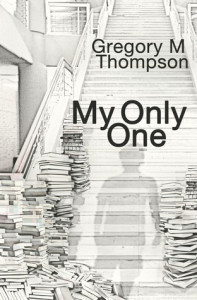 My Only One by Gregory M. Thompson
My Only One by Gregory M. ThompsonGregory M. Thompson’s books, My Only One and Moderia, which was a Dancon special which Greg calls a “horror epic poem.” It’s dedicated to Poe, and I thought it could be a nice addition to my lessons on poetry, especially since we discuss Annabel Lee.
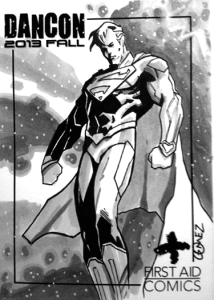 Superman Sketch Card by Juan Gomez
Superman Sketch Card by Juan GomezI had a chance to talk with artist Juan A. Gomez, whose sketch cards were just plain awesome. Anthony was lucky enough to purchase one (the very one Chris told me his brother wanted to buy, in fact. Poor Tim, Anthony beat you to it and even posted a picture of the card to rub it in). Of the sketch cards created for Dancon, Juan’s were some of my favorites. You can see the whole range of the sketch cards created for the show at the Dancon gallery here (Sorry if that link doesn’t work…It’s Facebook, after all; it isn’t like a real internet site — more like a Bizarro universe with it’s own laws and physics).
There’s more I could say about the day, but one final thing that I must mention is that I won one of the drawings of creator contributed stuff! Yes, that’s right. I bought items from more than three creators, turned my name in, and I didn’t win a copy of Raceboy and Super Qwok Adventures! Thankfully, the two donated copies went to people who I don’t know and am not related to who I hope will love the book and spread the word!
September 27, 2013
The Smell of Knowledge
One of my last year students stopped in my class today after second hour and said, “It smells like books in here.”
“That’s knowledge,” I replied. “My classroom smells like knowledge.”
She wrinkled her nose. “Knowledge doesn’t have a smell. If knowledge had a smell, it would be disgusting.”
September 22, 2013
In Media Res
No, I haven’t disappeared. I’m just not done with anything.
I wanted to post pictures of the home improvement projects I started last year … but I still haven’t finished! I still have rough cut oak to rip into trim, trimwork to stain and install, bookcase doors to stain, three doors to install upstairs (and of course, trim), windows to take out, brickwork to fix (see my previous post on replacing a rotted window ledge), and the list goes on. So…
I give up. I admit defeat. I will never be done. I will always be in between one thing and another, and the best I can do is show you what I’ve done so far.
Front Door
First, I replaced the front door.
 Original front door
Original front door New front door
New front doorBedroom to Office
The only room in the house that still has the original hardwood is the smallest bedroom. I hand sanded and refinished the floors in this room, retrimming it with a basic ranch style white trim.
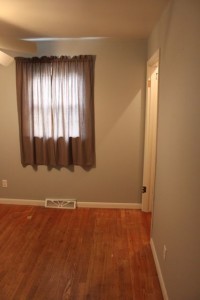 Office view #1
Office view #1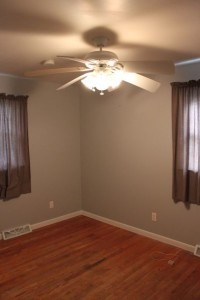 Office view #2
Office view #2Since these pictures were taken, the lamp has been replaced with a new light, the curtains have been replaced with new, more stylish curtains, both doors have been replaced, and I moved the bookshelves from the living room into the office to use despite their unfinished sides (more on this later).
I will not show you what the office looks like right now because it’s embarrassing. Everything I touch explodes. I’m not kidding, though I am speaking figuratively.
Living Room and Front Hall
The following gallery captures the evolution of the living room and the hallway to where it is right now. We re-floored it with three inch oak. I chose an Arts and Crafts style trim to emphasize the unpretentious, utilitarian nature of our house, which is a modest family home. It is not pretentious, and could never be remodeled to be pretentious. I think the abundance of oak adds a warm, earthy sense of home and welcome to the house.

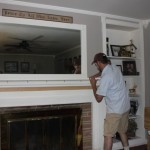





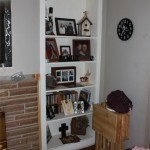

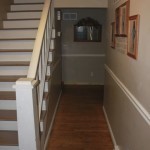
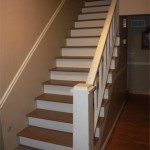
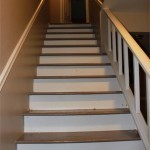





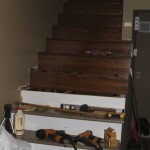
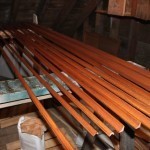

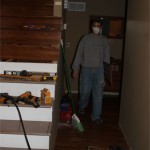
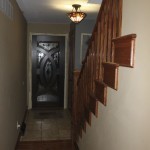
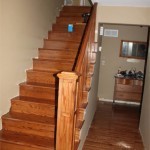


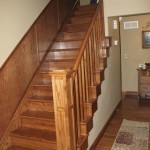

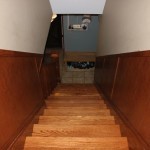
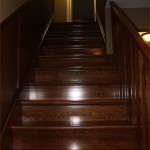

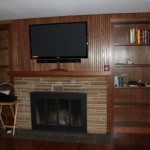

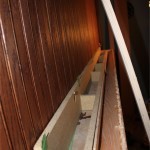

Wine Rack
My family — my parents and sisters — have begun making wine. I took out some shelves from our basement root cellar and built some racks to hold the finished products. I completed enough storage for 35 bottles; I haven’t gotten back to working on the racking to extend to the floor, but that should give us another 20 bottles. I realize that staggering the bottles would have increased the number of bottles I could have stored, but after trying to work through the math for a week, I stuck with symmetrical storage rather than staggered. I just could not wrap my brain around the measurements since the front pieces needed to be cut with one radius and the back boards needed a different radius.
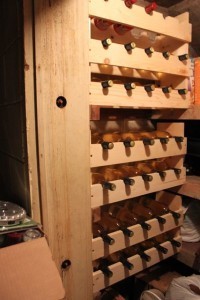 These wine racks were installed in place of shelves
These wine racks were installed in place of shelvesOther Improvements
I actually did hire some work to be done. Our roof was damaged in a hailstorm from May, 2012, and so paid a local contractor to replace the room. I did not lift a single tool for any of the work. If it had been me, we would still have tarps on the roof.
I also paid a tree service to remove the giant pine tree from the front yard. It was too close to the electrical line for me to tackle on my own.
And, we installed a circuit breaker box. No more fuses except in the garage.
In addition, I resealed the driveway. For most people, this would be a one day project, but for me, it was two weeks of dealing with intermittent rain. Once I finished the rain stopped.
Conclusion
Now hopefully I’ve caught you up on what I’ve been busy with, and why I haven’t done a better job posting. There’s still so much to do that I really shouldn’t be sitting here writing… but at least you know that it’s not a lack of work that’s kept me from writing — it’s too much!
May 9, 2013
Raceboy and Super Qwok Visit the Scribblenaut Universe
Alex and Bryan created their alter egos in the Wii U game, Scribblenauts Unlimited.
Here are some screen shots of the main characters from Raceboy and Super Qwok Adventures:
 Dr. Destructo: Is she disguised by screen artifacts on purpose?
Dr. Destructo: Is she disguised by screen artifacts on purpose?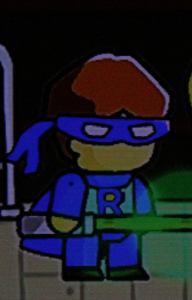 Raceboy
Raceboy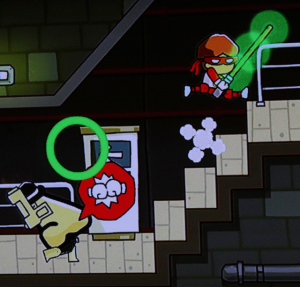 Nose Sinclair chases Super Qwok
Nose Sinclair chases Super Qwok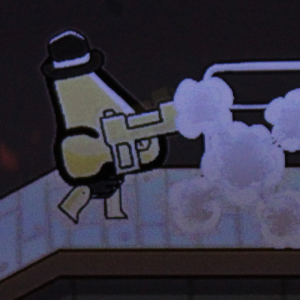 Nose Sinclair — apparently the game couldn’t just shoot big boogers
Nose Sinclair — apparently the game couldn’t just shoot big boogers Flowergirl
Flowergirl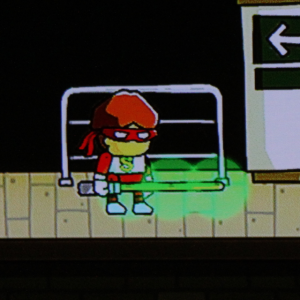 Super Qwok
Super QwokSince I took these pictures, Anna asked if she could play the Wii U. I turned it on for her. We only have three games, and she chose this one. I was busy working on the book shelves when I heard a cry of anguish. It was Alex; Bryan wasn’t home, or there would have been an even greater gnashing of teeth and yanking of hair.
Anna had deleted all four months worth of save data.

